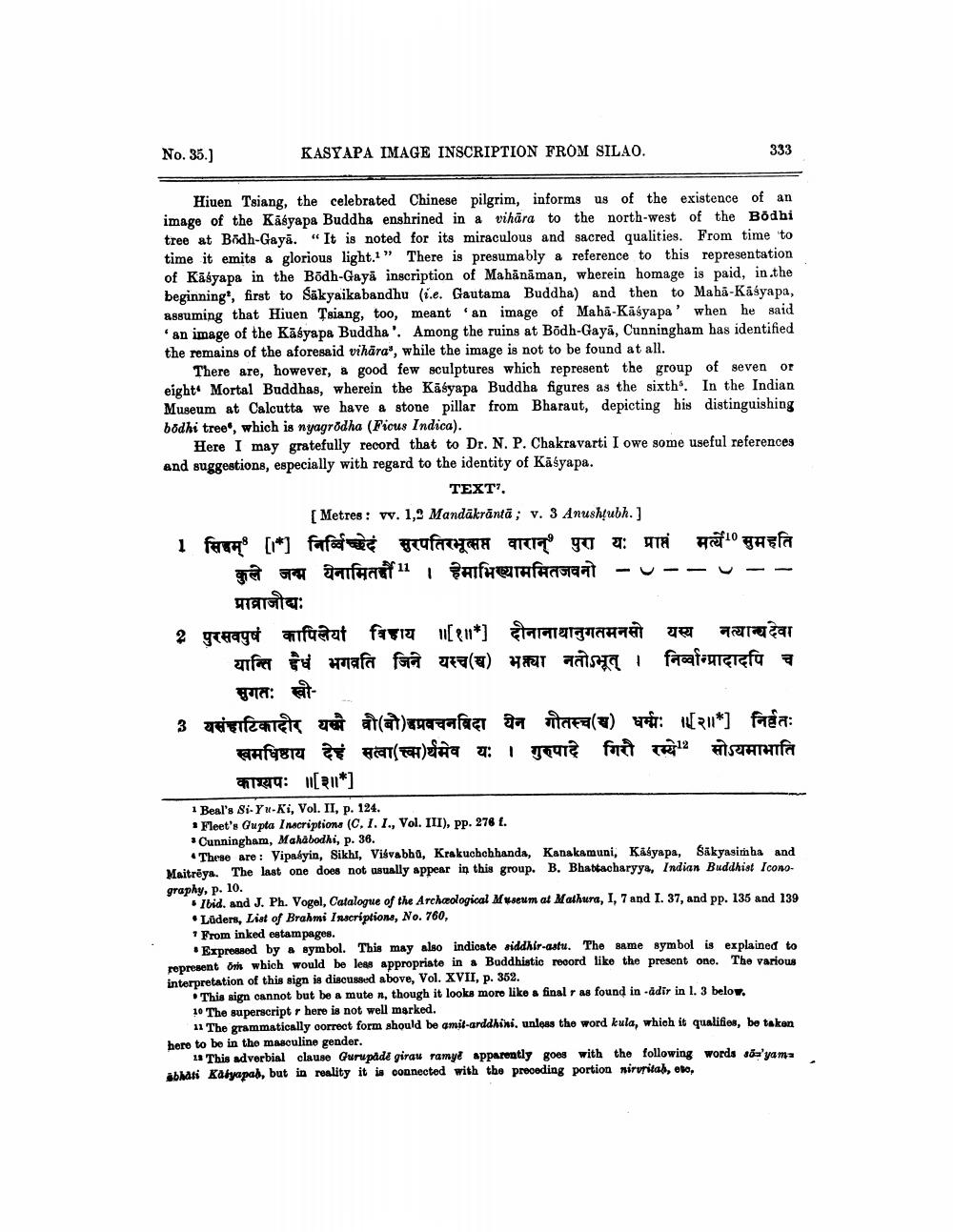________________
No. 35.]
KASYAPA IMAGE INSCRIPTION FROM SILAO.
333
Hiuen Tsiang, the celebrated Chinese pilgrim, informs us of the existence of an image of the Kasyapa Buddha enshrined in a vihara to the north-west of the Bodhi tree at Bödh-Gayā. "It is noted for its miraculous and sacred qualities. From time to time it emits & glorious light. There is presumably a reference to this representation of Kāgyapa in the Bödh-Gaya inscription of Mahānāman, wherein homage is paid, in the beginning', first to sākyaikabandhu (ie. Gautama Buddha) and then to Maha-Káśyapa, assuming that Hiuen Tsiang, too, meant an image of Maha-Kāśyapa' when he said
an image of the Käsyapa Buddha'. Among the ruins at Bödh-Gaya, Cunningham has identified the remains of the aforesaid vihara', while the image is not to be found at all.
There are, however, a good few sculptures which represent the group of seven or eight. Mortal Buddhas, wherein the Kāśyapa Buddha figures as the sixth. In the Indian Museum at Calcutta we have a stone pillar from Bharaut, depicting his distinguishing bodhi tree', which is nyagrodha (Fious Indica).
Here I may gratefully record that to Dr. N. P. Chakravarti I owe some useful references and suggestions, especially with regard to the identity of Käsyapa.
TEXT? [Metres : w. 1,9 Mandākrānta; v. 3 Anushçubh. ] 1 सिद्धम् [*] निर्बिच्छेदं सुरपतिरभूत्सप्त वारान् पुरा यः प्राप्तं म]। सुमहति
*** Taifhaafu , BATCHETAAN -U--u-- watotta: 2 पुरसवपुष कापिलेयां विहाय [१॥*] दीनानाथानुगतमनसो यस्य नत्यान्यदेवा
यान्ति वैध भगवति जिने यस्च(च) भक्त्या नतोऽभूत् । निर्वान्प्रादादपि च
ya: at 3 fatet e atlat a fazi ga starea() #: (211*] faha:
स्वमधिष्ठाय देहं सत्वा त्वार्थमेव यः । गुरुपादे गिरी रम्ये मोऽयमाभाति 19: [21*
1 Beal's Si-Yu-Ki, Vol. II, p. 124.
Fleet's Gupta Inscriptions (C. 1. 1., Vol. III), pp. 278 . * Cunningham, Mahabodhi, p. 36.
These are: Vipaśyin, Sikhi, Visvabha, Krakuchchhanda, Kanakamuni, Kasyapa, Säkyasimha and Maitreya. The last one does not usually appear in this group. B. Bhattacharyya, Indian Buddhist Icono graphy, p. 10.
. Ibid. and J. Ph. Vogel, Catalogue of the Archaeological Museum at Mathura, I, 7 and I. 37, and pp. 135 and 139 • Lüders, List of Brahmi Inscriptions, No. 760,
From inked estampages.
• Expressed by a symbol. This may also indicate siddhir-astu. The same symbol is explained to represent on which would be legs appropriate in a Buddhistic record like the present one. The various interpretation of this sign is discussed above, Vol. XVII, p. 352.
. This sign cannot but be a mute n, though it looks more like a final ras found in -adir in I. 3 belov. 10 The superscript here is not well marked.
11 The grammatically correct form should be amit-arddhini, unless the word kula, which it qualifies, be taken here to be in the masculine gender.
13 This adverbial clause Gurupade girau ramyd apparently goes with the following words são'yama äbhati Kabyapab, but in reality it is connected with the preceding portion niruritab, eto,




